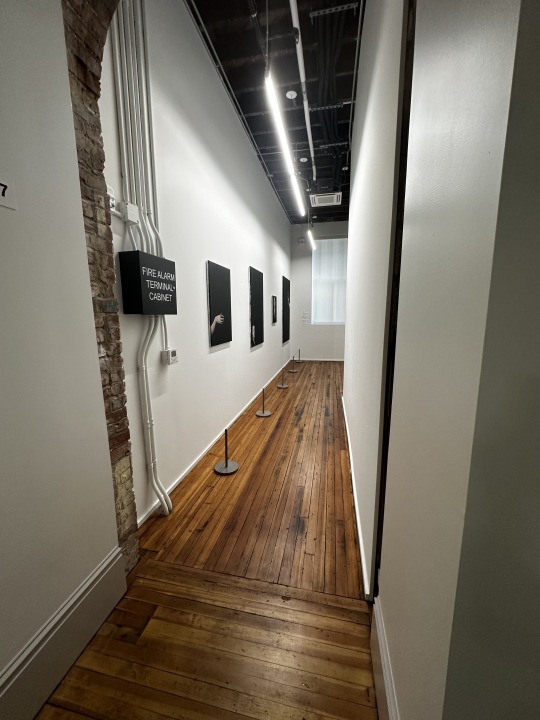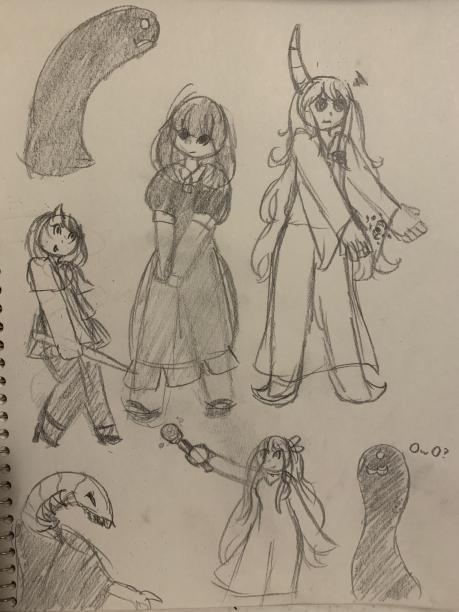#rozeal
Explore tagged Tumblr posts
Text
Highlights of
From Her Perspective: Intersections of Gender & Race

Bearing, 2006,
Bradley McCullum & Jacqueline Terry


African/American, 1998
Kara Walker
Untitled (from the Kitchen Table Series), 1990
Carrie Mae Weems


Liberation of Aunt Jemima and Uncle Ben, 1998
Renee Cox
Baby Back (American Family), 2001
Renee Cox

Rozeal
Painful,the appearance of a dime in the cling (after Yashitashi's painful, the appearance of a prostitute of the Kansei era), 2006

Mrs. O'Dell Broadway and the Breakfast Program, 2009
Michele Tejoula Turner


Histology of Different Classes of Uterine Tumors, 2006
Wangechi Mutu

Corridor Day, 2003
Lorna Simpson
#Mott Warsh Gallery#MW Gallery#flint michigan#from her perspective#art show#charles stewart mott#carrie mae weems#kara walker#bradley mccullum#jacqueline terry#rozeal#iona rozeal brown#renee cox#histology#feminism#wangechi mutu#black artist#photography#mixed media#lorna simpson#video art#sculpture#women artists#black women art
0 notes
Text
Rubell Museum - DC - Jan 13 2024
A trip to the Rubell Museum was something to look forward to despite my new Doc Martens slicing up my ankles during my 10-minute walk from the Waterfront Metro station. Opened on Oct 29th, 2022, the DC location at 65 I St. SW brought Mera and Don Rubell's collection of post-1980 art from Miami to the DC's Southwest neighborhood. This would be my second time visiting with my first experience viewing the inaugural exhibition What's Going On?. The collection showcased many artists I was not familiar with. It was a treat discovering new and exciting art. For me, artists that I wanted to learn more about from my last visit were Chase Hall, Hernan Bas and Christina Quarles.

Christina Quarles
Detail: Fell to Earth (Felt to Pieces), 2018
Acrylic on Canvas
Taking advantage of the gorgeous and expansive space past the entrance, the museum mounted works by Alexandre Diop - a Franco-Senegalese artist who, according to the website, "uses discarded objects to create work that raises questions pertaining to sociopolitical, cultural and gender issues. Drawing inspiration from his European and African roots, he explores the legacies of colonialism and diaspora while tackling universal themes of ancestry, suffering, and historical violence". The open space with its large cathedral-esque windows floods the space with natural light, showcasing all the wonderful varied textures and highlighting all the materials that Diop uses in his work.

Once you exit this room, you will enter a three-level building that was once part of Randall Junior High School, a historically Black public school that ceased operations in 1978. The Rubells purchased this historic site from the Corcoran College of Art and Design in 2010 for $6.5 million. The building was the site for the inaugural What's Going On? when the museum opened in 2022.
Although quite disorienting to navigate at first, each level essentially follows a radial floor plan. There will be an exhibit in the middle of the level when you first come, and then out in all directions are hallways that will lead to individual rooms with their own exhibits relating to the overall current exhibition - Singular Views: 25 Artists.
One of the biggest flaws in the architecture of the building or more importantly, how the architecture is utilized, is the decision to install art in the narrow hallways. These hallways doubtfully will pass the modern fire and safety code. Large enough to fit one individual through, there would often be two-dimensional works hanging on both sides of the wall. The proximity between the visitors and the works would make any conservator nervous. There is a serious bottleneck where a visitor must wait for another to pass through before entering these spaces. Needless to say, when there is a person waiting, one cannot help but exit in a hurried manner. This takes away any chance for close looking or truly connecting and appreciating the work.

Overall, the exhibition was something you would come to expect of the Rubell Museum (so far that I have seen in DC): colorful, vibrant, electric and featuring young artists, some in their early or mid careers. The standouts this time for me were Amoako Boafo, Otis Kwame Kye Quaicoe and Rozeal, whom I will be covering in separate posts so they each have their own spotlights.
3 notes
·
View notes
Photo






An Afro-Asiatic Allegory by Iona Rozeal Brown
5 notes
·
View notes
Text
Hello, lovely people of Tumblr!
It's great to be here! Once again, hello to everyone seeing this! I'm Rozeal Cecilia Zhao, a college student and Wattpad fanfiction author (formerly Hayami_Minato), and I am pleased to make my entrance to Tumblr!
Frankly speaking, I've been wanting to check this place out for a while, but my mind has been in different directions that I couldn't decide when would be the best time for me to arrive. But with that aside, let's get to know each other!
[What I'm Interested In]
Character creation & lore-writing
Anime fashion design/illustration
Fanfiction writing
Fanart illustration (though, I do things traditionally)
Lovecraftian horror
Gothic horror
Musical theatre
Classical music & opera
Non-maintream music
Singing
Guitar
Violin
Cats
Literature
Shakespearean plays
Visual novels
Anime
Etiquette
[What's Likely To Come From Me]
Honestly, it's not much to look from when it's me. But I will likely post some of my traditional art here and there; and if it doesn't hurt; perhaps I'll post some of my vocal recordings.
It won't happen too frequent, but I'm more likely to lurk around to watch and like some other fanarts- my ultimate guilty pleasure.
[What Brought Me To Tumblr?]
Again, it's fanarts I'm after. As someone who just draws on paper and isn't as experienced as professional artists, I can barely ever say I can be at their levels. But it doesn't stop one from appreciating others' work. I've always enjoyed the arts, so any form of it I have my sights set on, I'll know it's great to know I didn't come to this platform for nothing.
[Any Final Thoughts To Share?]
It truly is an honour to be in the prescence of many other artists and writers, who may I say have my highest respects regardless of genre or demographics. To all who see this, I sincerely look forward to everything there is to this platform.
Thank you for reading my introductary post. Let's all be able to appreciate artworks together.
#new post#new user#intro post#introductory post#introduction#first time#get to know me#get to know the blogger
1 note
·
View note
Photo

@bgcharaweek Day 4 - Free day
Sketch page collection
#kakepop art#kakepop sketch#tower of god#tog#kami no tou#bgcharaweek#katan#catan#endorsi jahad#gray#grey#hoh#rozeal#kukaku rakukakuka
15 notes
·
View notes
Photo

they’re happy together
12 notes
·
View notes
Text










30 Americans Exhibition at the Barnes Foundation 🤎
#30 Americans#barnes foundation#Nina Chanel Abney#John Bankston#Jean-Michel Basquiat#Mark Bradford#Nick Cave#Robert Colescott#Noah Davis#Leonardo Drew#Renée Green#David Hammons#Barkley L. Hendricks#Rashid Johnson#Glenn Ligon#Kerry James Marshall#Rodney McMillian#Wangechi Mutu#William Pope.L#Rozeal#Gary Simmons#Xaviera Simmons#Lorna Simpson#Shinique Smith#Henry Taylor#Hank Willis Thomas#Mickalene Thomas#Kara Walker#Carrie Mae Weems#me
81 notes
·
View notes
Photo

afro.died, T by Rozeal
1 note
·
View note
Text


#5 - Reconnect
Masterlist
Previous
Next
Let me know your thoughts in the reblogs <3
#grace floats the banana using shinsu#khunbam basically wearing matching outfits (nods at SIU)#there are actually more people like serena hoh and rozeal between khun and hatz but i can't make it too crowded#so it's easier to distinguish between characters#i love rak but he won't be around as often in the future :")#this might be the most funny and lighthearted update#we'll get serious next week#tower of god#tog#two sides of the same coin comic#my comic#my art#bam#baam#25th baam#25th bam#the 25th baam#the 25th bam#khun#koon#khun a.a#khun aguero agnis#jue viole grace#shibisu#ship leesoo#hatz#rak wraithraiser#rak#phonsekal laure#endorsi jahard
237 notes
·
View notes
Photo

Today, ‘30 Americans,’ the Rubell Family Collection's landmark show of works by African-American artists, opens at its 17th venue, The Barnes, in Philadelphia. We are proud to have distributed the exhibition catalog, now in its fourth, expanded edition, since its first printing in 2009, and we cannot recommend highly enough curator Gwendolyn DuBois Shaw's recent essay on “The 30 Americans Effect,” which makes a compelling case for how this one, visionary traveling exhibition has changed museums today. #rozeal #nickcaveartist #davidhammons #barkleyhendricks #mickalenethomas #hankwillisthomas #jeanmichelbasquiat #30americans @rubellcollection @barnesfoundation @artnews @professorshaw #30americanseffect #blackart #africanamericanart https://www.instagram.com/p/B4IErSuJ2e-/?igshid=1pl0loybm9eih
#rozeal#nickcaveartist#davidhammons#barkleyhendricks#mickalenethomas#hankwillisthomas#jeanmichelbasquiat#30americans#30americanseffect#blackart#africanamericanart
0 notes
Photo

Skern for @Rozealous // Thank you so much//
98 notes
·
View notes
Link
Also, I've got this to share too. Quite the #towerofgodtuesday indeed. XP
#towerofgod#tower of god#ToG#ToGTuesday#ToG Tuesday#towerofgodtuesday#tower of god tuesday#rozeal#voice acting#voiceacting
0 notes
Photo

Iona Rozeal Brown King Kata #3: Peel Out (after Yoshitoshi’s “Incomparable Warriors: Woman Han Gaku”), 2009 archival inkjet print 24 x 30 inches edition of 50
33 notes
·
View notes
Photo

Rozeal (formerly known as Iona Rozeal Brown)
American, born 1966
a3 #16 w.o.i.m.s., 2004
Acrylic on paper
https://museum.cornell.edu/collections/modern-contemporary/21st-century-painting
0 notes
Photo

Powerful Chakaia Booker sculptures in the fabulous exhibition FIERCE WOMEN at the Moss Art Center at VT. Also featuring Marylin Minter, Jenny Holzer, and Rozeal, Guerrilla Girls! Get on up there and check it out! (at Moss Arts Center, Virginia Tech) https://www.instagram.com/p/B796RG8hs6S/?igshid=35luh9f8ysgv
0 notes
